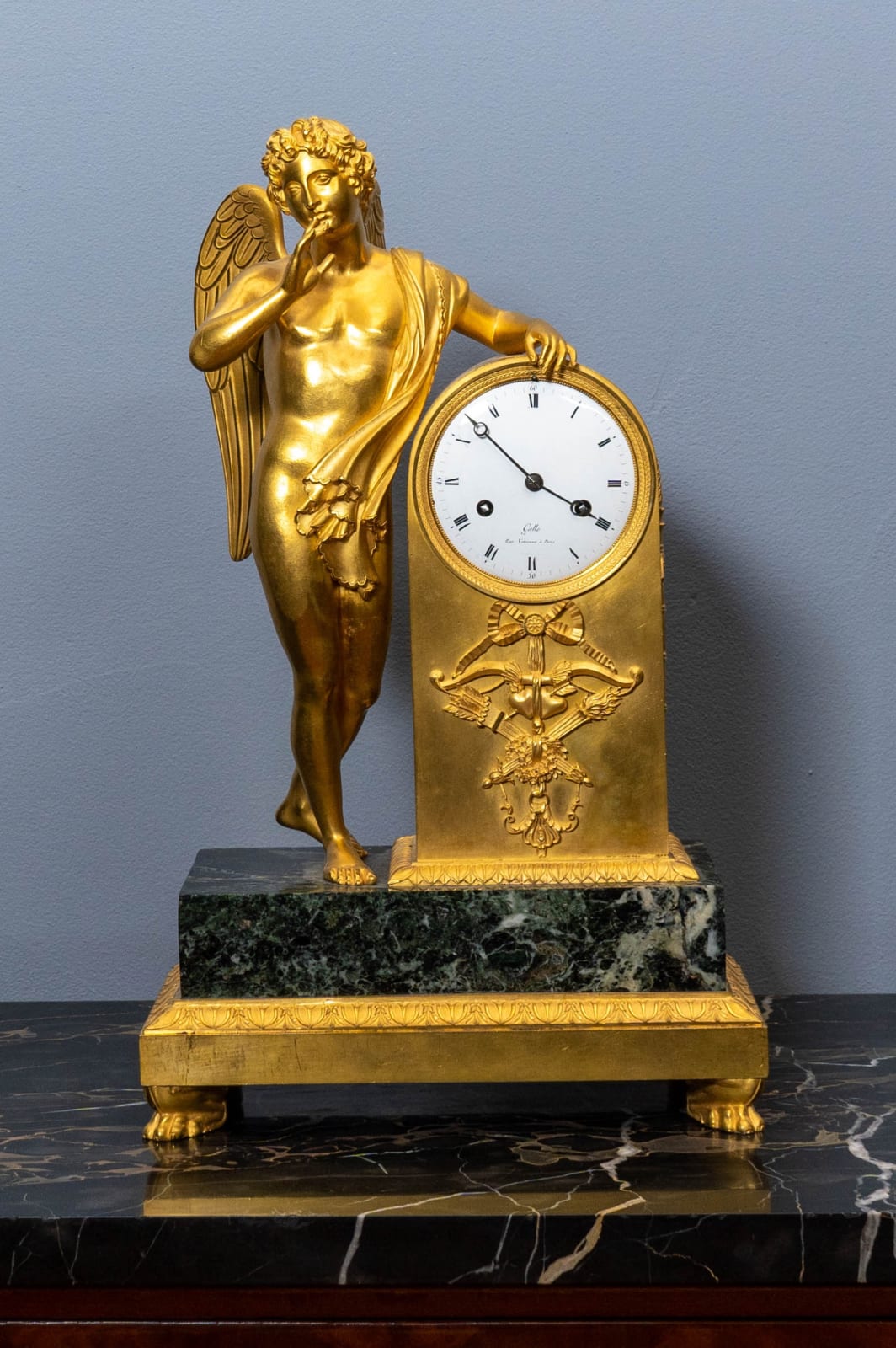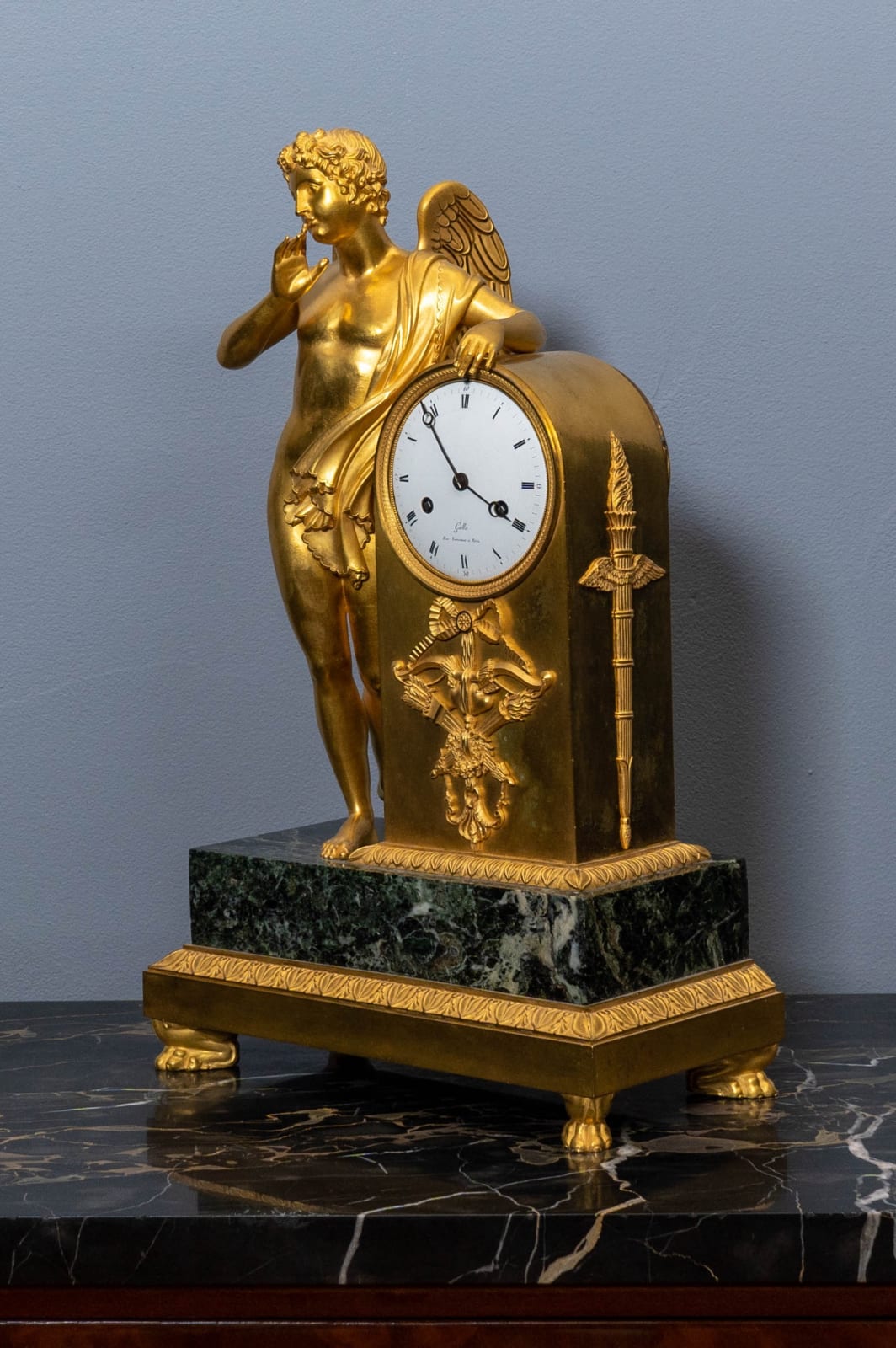Claude Galle
An Empire gilt bronze and green marble figural mantel clock, Paris, date circa 1810
Height 49.5 cm, width 30 cm, depth 16 cm.
Further images
A superb Empire gilt bronze and green marble mantel clock by Claude Galle of eight day duration, signed on the white enamel dial Galle Rue Vivienne à Paris, housed in a beautiful case depicting the Spirit of the Arts, the dial with a Roman hour chapter ring and outer minute ring marked 15/30/45/60 and a pair of blued steel Breguet-style hands for the hours and minutes. The movement with anchor escapement, silk thread escapement, striking on the hour and half hour on a single bell, with outside count wheel. The splendid case by Claude Galle featuring the standing figure of a youthful winged male nude representing the Spirit of the Arts, who wears nothing other than a cloak that drapes across his shoulder and lower torso, he holds one hand to his face while the other leans across a domed pedestal housing the movement and dial, the dial mounted below by a ribbon-tied bow centred below by hearts and a quiver of arrows crossed by a flaming torch, the sides of the pedestal mounted by flaming winged torches. The figure and pedestal on a rectangular green marble plinth on a stepped gilt bronze base with foliate border on lion paw feet
Paris, date circa 1810
Height 49.5 cm, width 30 cm, depth 16 cm.
Literature: Tardy, “Les Plus Belles Pendules Françaises”, 1943, P. 231, illustrating another Empire clock with case representing the Spirit of the Arts, by Pierre-Philippe Thomire at Château de la Malmaison. Cedric Jagger, “Royal Clocks”, 1983, p. 149, pl. 203 illustrating a comparable clock known as the Artium Genio clock with case by Pierre-Philippe Thomire in the British Royal Collection.
This sumptuous case model compares with a number of others from the period that represent the Spirit of the Arts or Génie des Arts, including the Artium Genio clock, which Claude Galle’s (1759-1815), contemporary bronzier Pierre-Philippe Thomire (1751-1843) supplied to George IV for Carlton House before 1813 and is now placed in Windsor Castle. As here, and in the example cited above at Château de Malmaison, the Spirit of the Arts is represented by a handsome winged male nude.
Alongside Thomire, Galle was one of the foremost bronziers and fondeur-ciseleurs of the late Louis XVI and Empire periods. He was born at Villepreux near Versailles and then travelled to Paris to begin an apprenticeship under the fondeur, Pierre Foy. In 1784 Galle married Foy’s daughter and on his father-in-law’s death in 1788 Galle took over the workshop, which he built up into one the finest of its kind with a workforce of about 400 craftsmen. Galle promptly moved the business to Quai de la Monnaie (renamed Quai de 1’Unité) and from 1805 operated from 60 Rue Vivienne. First listed in the trade registers in 1784 he was received as a maître-fondeur in 1786 and promptly gained the first of many commissions from the Garde-Meuble de la Couronne under Jean Hauré from 1786-88. He is known to have collaborated with Pierre-Philippe Thomire, amongst others, and was responsible for the majority of bronzes d’ameublement supplied during the Empire to Château de Fontainebleau. Other Imperial commissions included the supply of numerous figural clock cases, vases, ewers, light fittings and other fine bronze furnishings for the palaces at Saint-Cloud, the Trianons, Tuileries, Compiègne, Rambouillet and a number of the Italian palaces including Monte Cavallo, Rome and Stupinigi near Turin. Yet despite numerous important commissions Galle was often in debt, partly on account of his lavish life style and also since many of his clients, such as Prince Joseph Napoleon, failed to pay him. After his death Galle’s business was reopened and prospered under his son, Gérard-Jean Galle (1788-1846). His work can be found among the world’s finest collections including those mentioned above as well as the Musée National de Château de Malmaison, the Musée Marmottan in Paris, the Museo de Relojes at Jerez de la Frontera, the Residenz Munich and the Victoria and Albert Museum in London.





